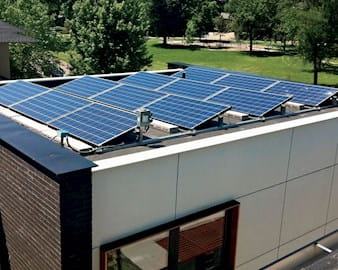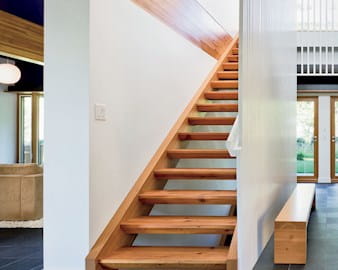
Melissa Schifman, MBA ’94, AM ’94, literally wrote the book on sustainable home building.
- By
- October 10, 2019
- Energy


Living in Phoenix in the early 2000s, Melissa Schifman, MBA ’94, AM ’94, often enjoyed hiking in the hills around the city—but not the air-quality alerts that warned hikers of hazardous air-quality conditions. “To not be able to go outside, and to think that we as humans did this to ourselves—something has to change,” she said.
For Schifman, that change literally began at home. Back in her native Minnesota a few years later, she and her husband embarked on a project to build a new house, making it as environmentally sustainable as possible. The US Green Building Council had just released guidelines for LEED (Leadership in Energy and Environmental Design) certification for residential homes, and Schifman dove into a thicket of regulations and recommendations for indoor air quality, energy efficiency, water efficiency, building materials, and landscaping.
“I basically became the project manager,” said Schifman, who had almost two decades of business experience. Tracking her challenges and triumphs on a blog about the experience, she realized that she had an opportunity to help other homeowners who might want to live more sustainably but didn’t know how. She became accredited as a LEED professional and wrote Building a Sustainable Home: Practical Green Design Choices for Your Health, Wealth, and Soul (2018) to help others follow in her footsteps. “I felt I had something to add to the industry because of my finance background and larger strategic outlook,” she said. “It made me think a lot about why we were doing this—and how other people could too.”
“It’s about feeling more like you are a part of the solution than part of the problem.”
— Melissa Schifman
Schifman has always loved nature, growing up skiing and biking in Minnesota. She majored in government at Georgetown, and after graduation worked as an energy and environmental policy adviser on Capitol Hill. Heading to the University of Chicago to pursue a masters in public policy, she decided to enroll in Booth for an MBA at the same time.

Her experience at Booth gave her a crash course in finance and business strategy that would later prove to be a strong asset in her work. “When it comes to figuring out return on investment for sustainability, my Booth experience not only helps me do the math, but it also gives me a lot of credibility,” she said. After her MBA, she went to work in finance for the airline industry, and then became the vice president of business development at Capella Education Company, before shifting to her career in sustainability.
Her experience building a green home coincided with becoming a mother, which gave her a heightened awareness of environmental impacts, both on future generations and on her own family’s well-being. “It’s not just about saving the planet; it really does have an impact on your health and an impact on your finances if you invest up front in the right way,” she said. She found that health hazards including volatile organic compounds—such as formaldehyde—that emanate from paints, cabinets, and carpets are rampant in most homes. Picking furnishings without VOCs can dramatically increase air quality, and installing a water filtration system can improve health, cut down on plastic use, and reduce costs.

Schifman was surprised to learn that many green products—such as recycled drywall and energy-smart appliances—don’t cost more than their traditional counterparts. Meanwhile, items such as triple-pane glass windows, solar panels, and a ground-source heat pump may cost more up front but save money over time. “That’s when you have to do a cost-benefit analysis and decide for yourself if, say, a seven-year return on investment is acceptable to you,” Schifman said.
In addition to the health and financial implications of building green, Schifman explores a third category in her book, which she calls “soul”—a catch-all for the intangible benefits that come from helping save the planet. “It’s about feeling more like you are a part of the solution than part of the problem,” she said. Many building choices can achieve all three goals. Reducing the size of your lawn and creating a wildflower garden can be aesthetically pleasing, aid pollinators, and cut down on resources and maintenance costs. Switching from a gas stove to an electric one can reduce fossil fuel consumption and improve indoor air quality.

Since building her own green home, Schifman has worked as a consultant for corporate and institutional clients, advising them on taking existing buildings and upgrading them to become LEED certified. But she continues to help homeowners in their quest for sustainability as well. She maintains her personal blog, and for the past year and a half she has also served as editor for Rise, an online platform that educates consumers and building professionals on the best products and techniques for sustainable home building. Through those efforts, she hopes to teach people how their building decisions—whether they are building a home from scratch or carrying out a home-improvement project—affect both individual welfare and environmental health. “People think about food choices or transportation choices, but they don’t often think about their home as a way to impact the environment,” Schifman said. “We are trying to make it less difficult to do the research so people can make better decisions on how to build.”
Communication Is Key
The most important thing when starting out on a sustainable building project, said Schifman, is to be clear on your goals. For example, are you trying to achieve net-zero energy? Cut heating costs? Or make a healthy home for your family? “You need to discuss it over and over again with contractors,” she said. Contractors are busy people, and may not be up-to-date on the latest environmentally friendly materials and methods, requiring more involvement from you on a project than usual. “There is no such thing as overcommunication,” Schifman said.
Pick Your Green Battles
A common mistake Schifman sees with new clients is seeking perfection and getting overwhelmed. In reality, everyone has time and budget constraints and will have to narrow what they can accomplish. “Maybe you go for triple-pane windows and spray foam insulation, but don’t do solar initially,” Schifman said. “There are always going to be trade-offs.” Schifman also recommends keeping it simple, and making one choice for all of the countertops, or carpets or tiles, in a home, rather than picking a different one for each room.
Prioritize the Climate
Most people don’t know that buildings are responsible for 39 percent of the carbon emissions that lead to global warming. So for individuals, Schifman says, your own home is probably your biggest carbon footprint. By making your home more energy efficient, and switching from gas-powered appliances to electric (for your heating, water heating, stove, and dryer), homeowners can be a necessary part of our transformation to a clean-energy economy. “It’s our generation leading right now, and we all need to step up. This isn’t a problem we can afford to leave to our children.”
MORE IN THIS SERIES
On a Mission to Send ‘Citizen Astronauts’ to the Stars »
A Globe-Trotting Couple on Their Approach to Wine Making »
Introduction to Photography from Self-Taught Diego Gil, ’11 »
David Collette’s Search for His Family’s History: An Introduction to Exploration »